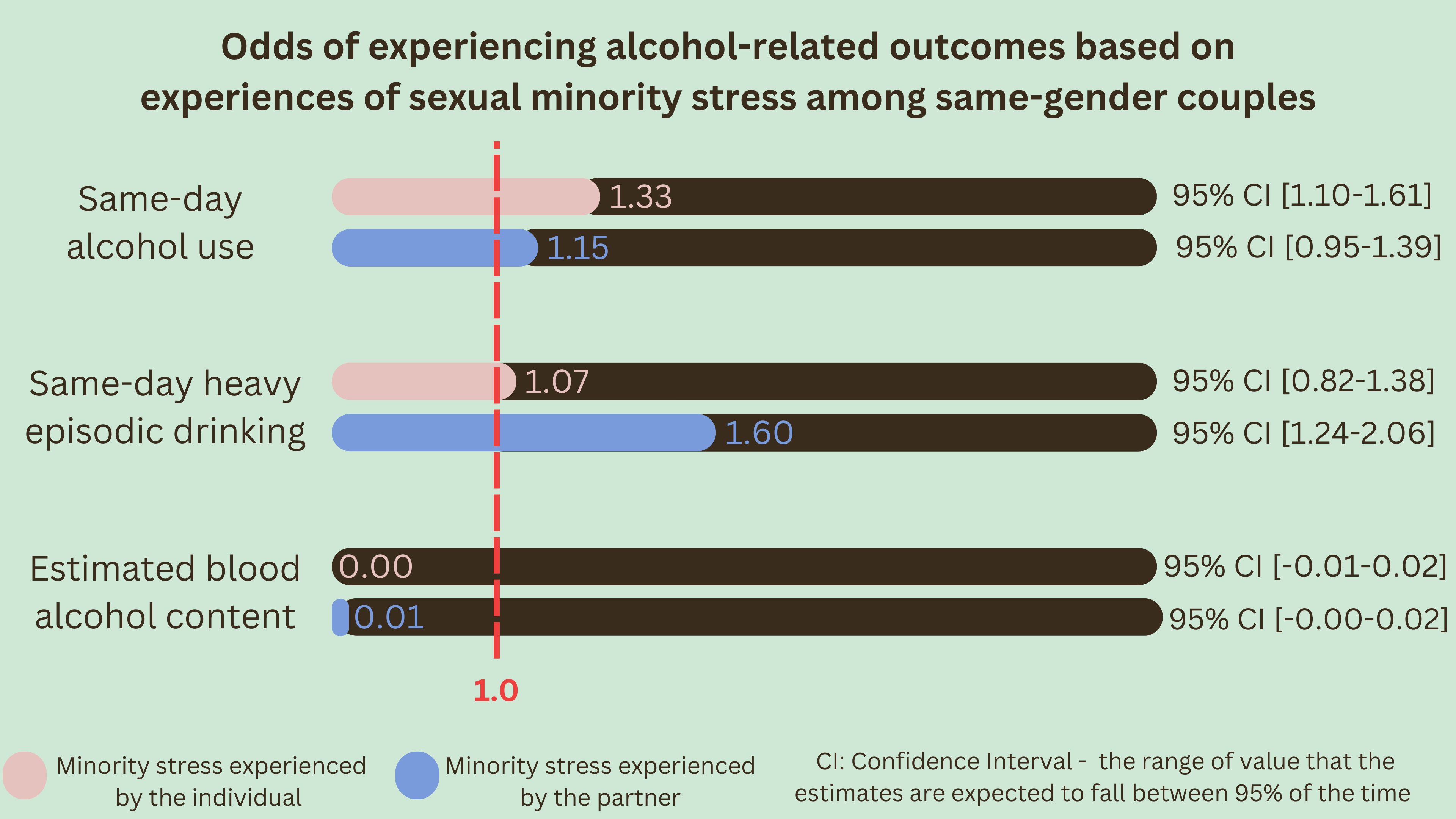Sexual minority women[1] have higher rates of hazardous episodic drinking when compared to heterosexual women. Sexual minority stress, such as harassment and discrimination based on one’s sexual orientation, might contribute to this behavior. The Dyadic Health Model suggests that sexual minority women are more likely to drink on days when they, or their partners, have experienced sexual minority stress. This week, The DRAM reviews a study by Alyssa L. Norris and colleagues that investigated how sexual minority stress experienced by one individual in a same-gender couple might impact alcohol use among both individuals in that couple, and determined whether this association was moderated by relationship functioning. For instance, very close couples might be especially resilient to stigma and discrimination due to the high level of social support they receive.
What were the research questions?
(1) How does sexual minority stress experienced both individually and by a partner impact alcohol use among sexual minority women and (2) is this association moderated by relationship functioning?
What did the researchers do?
The data used in this study was gathered from a larger study that also focused on same-gender, female couples. Three hundred and eighteen cisgender women in same-gender couples were recruited via a market research firm. The researchers measured self-reported experiences of sexual minority stress of both the individual and their partner, daily alcohol use, hazardous episodic drinking, estimated blood alcohol content (eBAC), and relationship functioning by analyzing participant’s daily diary entries within a two-week period. The researchers then analyzed relationships between these measures using generalized linear mixed models.
What did they find?
Alcohol use was reported in 54.3% of the sample, and 31.5% reported hazardous alcohol use. Additionally, 50% of participants reported experiencing instances of sexual minority stress. One’s own experience of sexual minority stress was associated with increased odds of drinking on the same day, when compared to those who did not encounter minority stress on that day. Similarly, among participants who reported alcohol use, hazardous episodic drinking was more likely on days when their partner experienced instances of sexual minority stress (see Figure). However, there was no association between minority stress experiences and increased eBAC. Finally, relationship functioning did not appear to moderate the relationship between minority stress and daily/hazardous episodic drinking. However, participants with greater relationship functioning reported lower levels of eBAC, generally.

Figure. Odds that a person will experience alcohol-related problems after instances of sexual minority stress experienced either individually or by a partner. Odds ratios can be interpreted as being X times more likely to report the outcome (i.e., alcohol use). For example, participants who experienced minority stress individually were found to be 1.33 times more likely to engage in same-day alcohol use when compared to those who did not experience minority stress on that day. Click image to enlarge.
Why do these findings matter?
These findings suggest that women in same-gender couples may use alcohol to cope with the stigma and discrimination they–or their partners–encounter. Given the dangerous effects of heavy drinking, future studies should focus on exploring how a partner’s stress may influence substance use within the relationship. Couple-level interventions, such specialized couple’s treatment programs that address factors like intimacy and internalized homophobia, should be implemented to promote healthy drinking behavior. However, these programs are currently scarce.
Every study has limitations. What are the limitations in this study?
The researchers were not able to identify whether drinking happened before or after instances of minority stress each day. Future research could use Ecological Momentary Assessment to gain a better understanding of the sequence of stigma-alcohol associations. The study’s findings were also based on self-report which could be subject to recall bias and/or social desirability which might have had an impact on survey responses, and therefore, the study’s findings. Lastly, the participants were primarily White, lesbian women which prevented researchers from analyzing any intersecting roles that race, ethnicity, or sexual identity might have had on alcohol use outcomes.
For more information:
The National Institute on Alcohol Abuse and Alcoholism has tips and resources for people struggling with problem drinking. For additional drinking self-help tools, please visit our Addiction Resources page.
— Nakita Sconsoni, MSW
What do you think? Please use the comment link below to provide feedback on this article.
________________
1. Sexual minority women is a term that encapsulates individuals who identify as LGBTQIA+ and/or endorse same-gender/sex attraction or sexual/dating behavior. The population of this study consisted of cisgender females in same-gender relationships.




